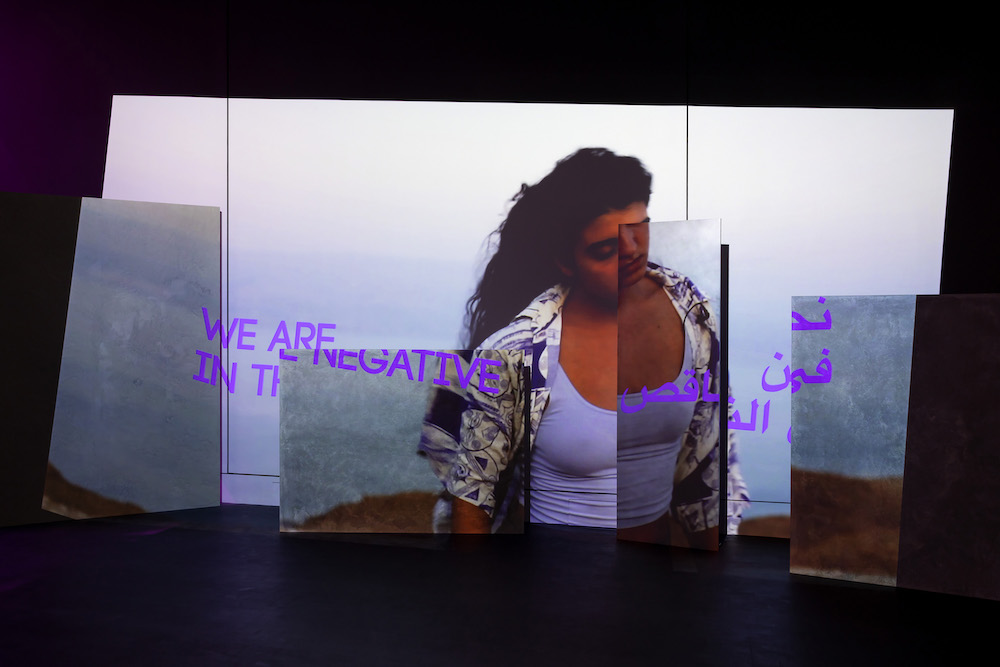In the 18th century, when the Iranian elite heard rumors of the grand mirrored halls of Europe, they sent merchants to procure as many sheets of brilliant reflective glass as their boats could carry. Still, the mirrors cracked in their elaborate frames somewhere between Venice and Tehran. Rather than attempt to reassemble the shattered glass, artisans inlaid the thousands of pieces in sweeping geometrical patterns along walls and across ceilings. The mesmerizing designs accentuated these tesserae pieces but also distorted the surface reflection, fragmenting the viewer’s image and intermixing it with that of peripheral objects and other people.
Palestinian artists Basel Abbas and Ruanne Abou-Rahme create similarly revelatory mosaics not from glass but from pieces of archival footage, original documentary imagery, soundscapes and text. Their multisensory installations mirror the dispossession of diasporic communities, evoking fracture on a visceral level.
Abbas and Abou-Rahme first met in 2007 when their respective performance-based practices converged: Abbas’ DJing and Abou-Rahme’s work in video design. More than a decade later, performance remains at the heart of their ongoing collaborative practice. Through their nondiegetic sound collages and multiscreen projections, they position performance as political action in which collective movement engenders resistance and resilience. According to the collaborative duo, collective sound and movement rituals—including song, poetry, dance and gesture—afford displaced communities a critical means for resisting their own erasure while reclaiming a sense of self and fraternity.

Installation view of May amnesia never kiss us on the mouth: only sounds that tremble through us, 2022, Basel Abbas / Ruanne Abou-Rahme. An echo buried deep deep down but calling still. © Astrup Fearnley Museet, 2023. Photo: Christian Øen
Their immersive installations are poised at the intersection of body, affect and space, negotiating between physical, digital and virtual realms. A three-channel video projected onto overlapping screens project film clips, graphic animation and excerpts of text by the artists and other authors. At the same time, enormous speakers produce pounding bass lines and rhythmic chanting. A phantasmagoria of moving images breaks apart, flashes, descends and dissipates across a collage of small and large rectangular screens, producing a disjointed viewing experience not unlike that of looking into a tessellated mirror.
In their decade-long project, May amnesia never kiss us on the mouth (2010–ongoing), Abbas and Abou-Rahme intermingle original footage with video clips sourced from online archives and social media posts of people singing and dancing in Palestine, Yemen, Iraq and Syria. Using a handheld camera, they record people’s improvised interactions with the land, preserving the real-time unfolding of a moment that, in their words, “can activate something that was otherwise inactive,” and gesture to the invisible just beneath the material surface. By merging archival and original film, the artists forge connections across time and geographical locations and visualize the legacy of resistance in a way that allows the past to instruct and inspire the present.
“We are engaged in producing a nonlinear reading of ‘our’ time that allows for a sense of multiplicity both conceptually and formally,” say the artists. To that end, their projects are formally malleable, continuous, “unbounded” and capable of accommodating shifting responses to ongoing events.

Installation view of May amnesia never kiss us on the mouth, 2022. The Museum of Modern Art, New York. Digital Image © 2022 The Museum of Modern Art, New York. Photo by Jonathan Muzikar.
For example, their most recent work, Only sounds that tremble through us (2020–22), first shown at the Museum of Modern Art in 2022 and now open at MIT List Visual Arts Center, revisits the material and conceptual concerns animated by May amnesia. In collaboration with Palestine-based performers—dancer Rima Baransi, electronic musicians Haykal, Julmud and Makimakkuk—Abbas and Abou-Rahme filmed their respective performative responses to the original archival footage of people dancing and singing at weddings, funerals, political demonstrations and impromptu social gatherings. These fresh improvisations both echo and evolve the inherited gestures, lyrics and rhythms. The looping voices and images increase in urgency, capturing the perpetual dream of Palestinians in the diaspora to finally return to “the lost ground of our origin, the broken link with our land and past,” in the words of Palestinian-American literary critic Edward Said.
Juxtaposition, symmetry and abstraction precipitate resonant connections between the seen and unseen, the spoken and the unspoken, without imposing any artificial structural unity onto the flux of images and texts. Complex layers of rhythm and repetition celebrate the generative possibilities of mutability, simulating how someone, in becoming other, can become more fully themselves. In this way the installation unites the degradation and violence of colonial conditions with the exaltation of collective endurance and ingenuity in Möbius strip continuity.
Through montage, the artists accommodate the complexity and multiplicity of experience—and the stories we tell about experiences—while pointing toward radical new formulations of identity and culture that disregard geopolitical boundaries. Just as the shattered glass recast perception, intermingling the self and other, Abbas and Abou-Rahme’s segments and soundbites envisage the possibility of “transcending the material constraints of individuality to see ourselves reflected in the glittering constellation of everyone else.”


